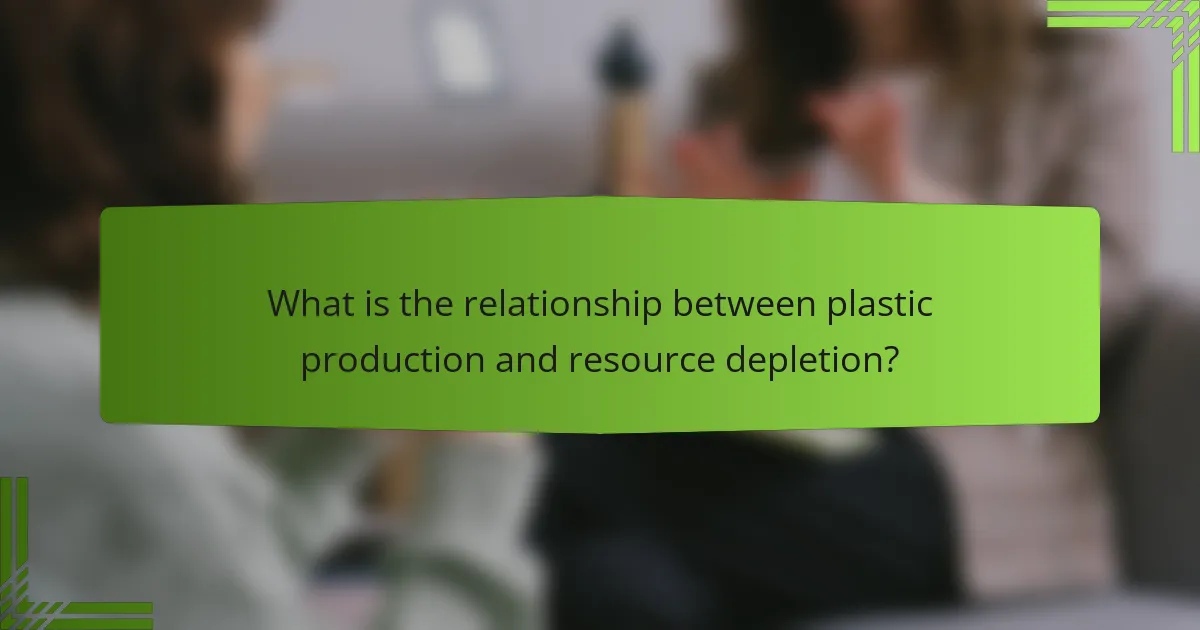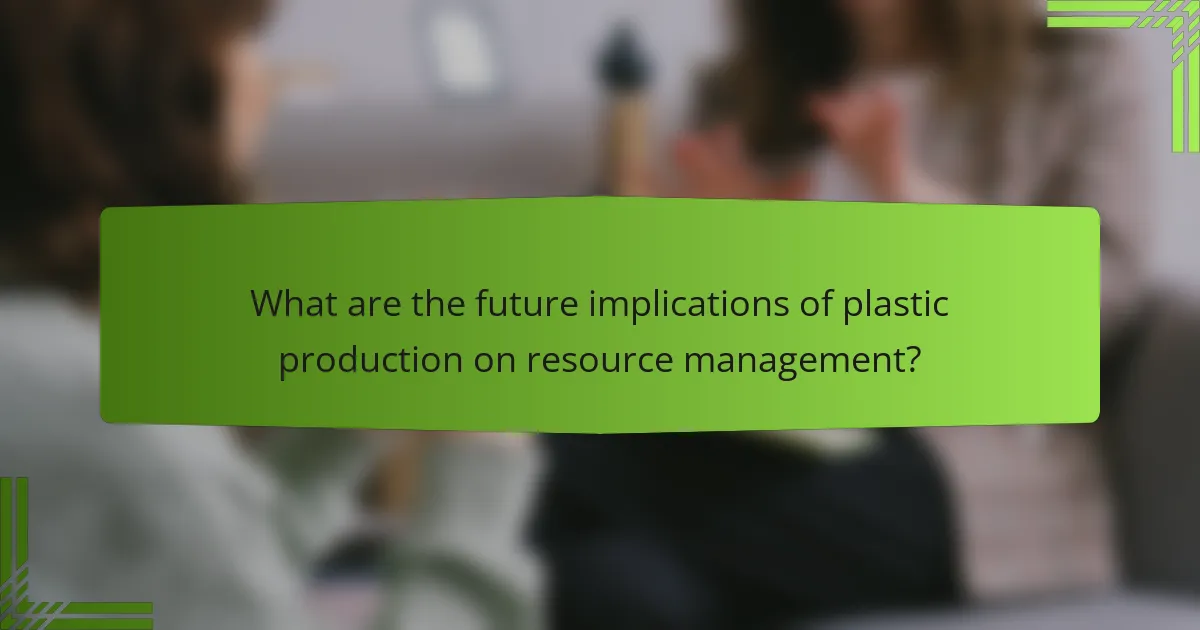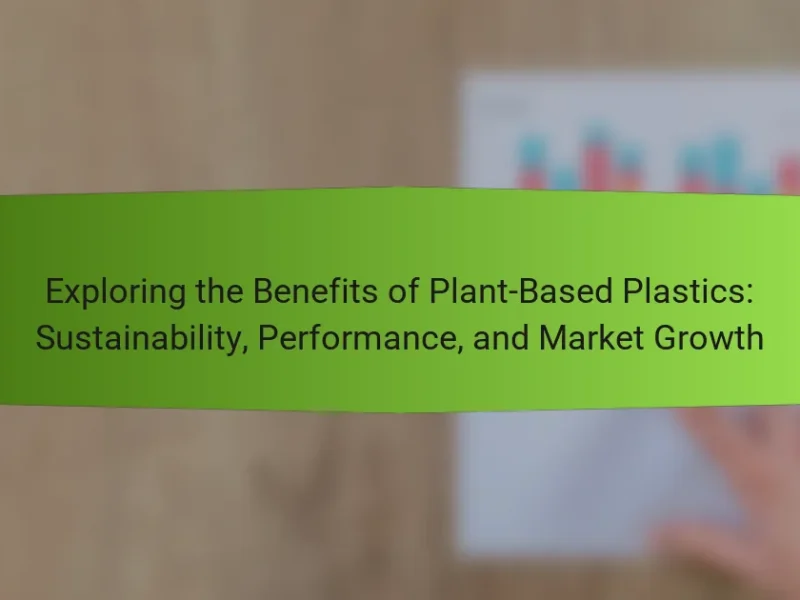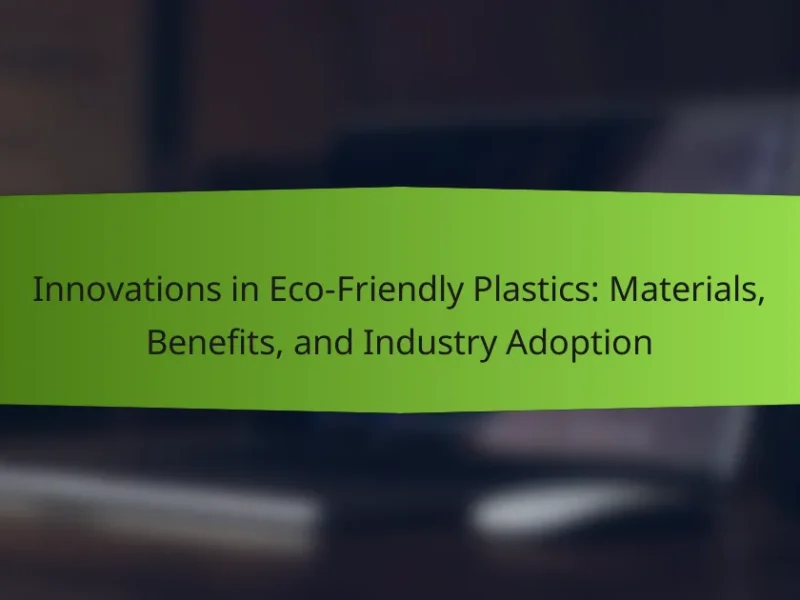Plastic production is primarily derived from non-renewable fossil fuels, such as oil and natural gas, leading to significant resource depletion and environmental degradation. The World Economic Forum highlights that by 2030, plastic production could generate 1.3 gigatons of greenhouse gases annually, further exacerbating climate change. Alternatives to traditional plastics, including bioplastics made from renewable biomass, recycled plastics, and biodegradable polymers, are emerging as sustainable solutions to mitigate these issues. The article explores the relationship between plastic production and resource depletion, emphasizing the need for innovative materials and improved recycling processes to address the environmental challenges posed by current plastic manufacturing methods.

What is the relationship between plastic production and resource depletion?
Plastic production is directly linked to resource depletion. The process requires significant amounts of fossil fuels, primarily oil and natural gas. According to the World Economic Forum, over 99% of plastics are derived from these non-renewable resources. Extracting and processing fossil fuels contributes to environmental degradation and depletes finite resources. Furthermore, the production of plastic contributes to greenhouse gas emissions, exacerbating climate change. Research indicates that by 2030, plastic production could account for 1.3 gigatons of greenhouse gases annually. This relationship highlights the unsustainable nature of current plastic production methods, emphasizing the need for alternative materials and recycling efforts to mitigate resource depletion.
How does plastic production impact natural resources?
Plastic production significantly impacts natural resources by depleting fossil fuels and consuming water. The manufacturing process primarily relies on petroleum, a non-renewable resource. According to the World Economic Forum, about 8% of global oil production is used for plastic. This extraction contributes to environmental degradation and greenhouse gas emissions. Additionally, plastic production requires substantial amounts of water, leading to water scarcity in some regions. The production of one kilogram of plastic can consume up to 2,000 liters of water. This heavy reliance on finite resources raises concerns about sustainability and long-term availability.
What raw materials are essential for plastic production?
The essential raw materials for plastic production are hydrocarbons derived from fossil fuels. These hydrocarbons are primarily sourced from crude oil and natural gas. Polyethylene, polypropylene, and polystyrene are common plastics produced from these materials. The production process involves polymerization, where monomers are chemically bonded to form polymers. According to the American Chemistry Council, around 99% of plastics are derived from fossil fuels. This reliance on non-renewable resources raises concerns about sustainability and resource depletion.
How does the extraction of these raw materials contribute to resource depletion?
The extraction of raw materials for plastic production contributes to resource depletion by depleting finite natural resources. This process involves extracting fossil fuels, minerals, and biomass, which are limited in availability. For example, petroleum extraction for plastic accounts for approximately 8% of global oil consumption. Over-extraction leads to diminished reserves and increased environmental degradation. Additionally, mining for minerals like bauxite and lithium results in habitat destruction and loss of biodiversity. Studies show that unsustainable extraction practices can lead to irreversible damage to ecosystems. This depletion affects future generations’ ability to access these essential resources.
Why is sustainability important in the context of plastic production?
Sustainability is crucial in plastic production to mitigate environmental impact. Plastic production relies heavily on fossil fuels, leading to resource depletion. The production process emits significant greenhouse gases, contributing to climate change. Sustainable practices can reduce energy consumption and waste generation. For instance, using recycled materials can minimize the need for virgin resources. Additionally, sustainable plastic alternatives can decrease pollution in oceans and landfills. According to the World Economic Forum, only 9% of plastic is recycled globally. Transitioning to sustainable methods can enhance recycling rates and promote a circular economy.
What are the environmental consequences of unsustainable plastic production?
Unsustainable plastic production leads to significant environmental consequences. It results in increased greenhouse gas emissions. According to the United Nations Environment Programme, plastic production and disposal contribute 3.8 gigatons of CO2 equivalent annually. This exacerbates climate change and impacts ecosystems. Additionally, plastic waste pollutes oceans and waterways. An estimated 8 million tons of plastic enter oceans each year, harming marine life. Furthermore, unsustainable practices deplete natural resources. The extraction of fossil fuels for plastic requires extensive land use and water consumption. This disrupts habitats and biodiversity. The accumulation of microplastics in soil and water sources poses health risks to wildlife and humans. These facts illustrate the critical need for sustainable practices in plastic production.
How can sustainable practices mitigate resource depletion?
Sustainable practices can mitigate resource depletion by promoting efficient use of materials. These practices include recycling, reducing waste, and using renewable resources. For instance, recycling plastic reduces the need for new raw materials. According to the EPA, recycling one ton of plastic can save approximately 7.4 cubic yards of landfill space. Additionally, using renewable resources like plant-based materials can decrease reliance on finite fossil fuels. The shift towards sustainable agriculture also preserves soil health, reducing the need for synthetic fertilizers. Implementing these practices can lead to a significant reduction in resource extraction and environmental impact.

What are the alternatives to traditional plastic production?
Bioplastics are a primary alternative to traditional plastic production. They are derived from renewable biomass sources like corn, sugarcane, and potato starch. Bioplastics can be biodegradable or compostable, reducing environmental impact. Another alternative is recycled plastics, which involve reprocessing existing plastic waste. This method conserves resources and minimizes landfill contributions. Additionally, biodegradable polymers made from natural materials, such as polylactic acid (PLA), offer eco-friendly options. Innovations in materials like mycelium and algae-based plastics are also emerging. These alternatives aim to reduce reliance on fossil fuels and lower carbon emissions. Studies indicate that bioplastics can significantly decrease greenhouse gas emissions compared to conventional plastics.
What types of alternative materials are available?
Alternative materials include bioplastics, recycled plastics, natural fibers, and metal. Bioplastics are derived from renewable sources like corn starch or sugarcane. Recycled plastics are processed from post-consumer waste, reducing landfill impact. Natural fibers, such as hemp and jute, are biodegradable and sustainable. Metals like aluminum can be reused indefinitely without quality loss. These materials help reduce reliance on traditional plastics, promoting sustainability.
How do these alternatives compare in terms of sustainability?
The sustainability of alternatives to conventional plastics varies significantly. Biodegradable plastics, for example, decompose more easily than traditional plastics. This reduces long-term environmental impact. However, their production can still involve resource-intensive processes. Plant-based materials, like polylactic acid (PLA), often require agricultural inputs. This can lead to land use changes and potential food supply issues.
Recycled plastics have a lower carbon footprint than virgin plastics. Recycling reduces the need for new raw materials. However, the efficiency of recycling systems varies widely. Some alternatives, like glass and metal, are highly recyclable but require significant energy for production.
Overall, the sustainability of each alternative depends on its life cycle impacts. Factors include production methods, resource use, and end-of-life options. A comprehensive assessment is essential for understanding their overall sustainability.
What are the benefits and drawbacks of using alternative materials?
Alternative materials offer several benefits and drawbacks. Benefits include reduced environmental impact and sustainability. Many alternative materials are biodegradable or recyclable. For instance, bioplastics can decompose naturally, unlike traditional plastics. This helps decrease landfill waste and pollution. Additionally, alternative materials often utilize renewable resources. This can lessen dependency on fossil fuels.
However, drawbacks exist as well. Some alternative materials may have higher production costs. This can limit their widespread adoption in industries. Performance and durability can also be issues. Certain alternatives may not match the strength of conventional materials. Furthermore, the availability of raw materials can be inconsistent. This can hinder supply chains and increase prices. Overall, while alternative materials present promising solutions, challenges remain in their implementation.
How can we transition towards more sustainable plastic production?
Transitioning towards more sustainable plastic production requires adopting bio-based feedstocks. These feedstocks, derived from renewable resources, reduce reliance on fossil fuels. Implementing advanced recycling technologies can also enhance sustainability. These technologies can convert plastic waste back into raw materials. Additionally, promoting circular economy practices minimizes waste and maximizes resource reuse. Research shows that transitioning to sustainable practices can significantly decrease carbon emissions. For instance, a study by the Ellen MacArthur Foundation indicates that adopting circular economy principles could reduce greenhouse gas emissions by 45% by 2030.
What strategies can industries adopt to reduce their plastic footprint?
Industries can adopt several strategies to reduce their plastic footprint. They can implement sustainable sourcing of materials. This includes using biodegradable or recycled alternatives to traditional plastics. Companies can also redesign products for longevity and recyclability. Reducing packaging waste is another effective strategy. Implementing take-back programs encourages recycling and reduces waste. Industries should invest in innovative technologies for plastic waste reduction. Collaborating with suppliers for sustainable practices can further minimize plastic use. Finally, educating consumers about responsible disposal can enhance recycling efforts. These strategies collectively contribute to significant reductions in plastic footprints across industries.
How can consumers play a role in promoting sustainable practices?
Consumers can promote sustainable practices by making informed purchasing decisions. Choosing products with minimal packaging reduces plastic waste. Supporting brands that prioritize sustainability encourages eco-friendly practices. Participating in recycling programs helps divert waste from landfills. Advocating for policies that protect the environment influences corporate behavior. Educating others about sustainability increases community awareness. Research shows that consumer demand can drive companies to adopt greener practices. A 2021 study by Nielsen found that 81% of global consumers feel strongly that companies should help improve the environment.

What are the future implications of plastic production on resource management?
Plastic production significantly impacts resource management by increasing demand for fossil fuels and raw materials. As plastic production rises, it strains natural resources such as oil and natural gas. The World Economic Forum reports that plastic production could account for 20% of global oil consumption by 2030. This escalating demand can lead to resource depletion and environmental degradation. Furthermore, plastic waste management remains a challenge, complicating resource recovery. Inefficient recycling processes hinder the sustainable use of materials. The future may require innovative solutions to balance plastic use with resource conservation. Transitioning to alternative materials could alleviate pressure on finite resources.
How might technological advancements change plastic production?
Technological advancements may significantly change plastic production by enhancing efficiency and sustainability. Innovations like bioplastics and recycling technologies can reduce reliance on fossil fuels. Advanced manufacturing techniques, such as 3D printing, allow for less waste and more precise production. Automation in production lines can increase speed and reduce labor costs. Improved chemical recycling methods can convert plastic waste back into raw materials. These advancements can lead to a circular economy, minimizing resource depletion. According to a report by the Ellen MacArthur Foundation, adopting circular practices could save the global economy $1 trillion by 2030.
What role do innovations play in reducing resource depletion?
Innovations play a crucial role in reducing resource depletion by enhancing efficiency and promoting sustainable practices. Advanced technologies, such as recycling processes, minimize the need for virgin materials. For instance, innovations in bioplastics utilize renewable resources, reducing reliance on fossil fuels. Energy-efficient manufacturing techniques lower resource consumption significantly. Research shows that adopting circular economy principles can decrease waste and extend resource life cycles. According to a study by the Ellen MacArthur Foundation, transitioning to a circular economy could save $1 trillion annually in resource costs. These advancements demonstrate that innovation directly contributes to conserving resources and promoting sustainability.
What best practices can be implemented for sustainable plastic production?
Implementing best practices for sustainable plastic production involves utilizing renewable resources, minimizing waste, and enhancing recycling processes. Using bio-based materials reduces reliance on fossil fuels. Adopting closed-loop systems can minimize waste by recycling plastic back into production. Employing energy-efficient manufacturing techniques lowers carbon emissions. Implementing life cycle assessments helps identify environmental impacts. Collaborating with stakeholders fosters innovation in sustainable practices. These strategies collectively contribute to reducing the ecological footprint of plastic production.
How can companies measure their sustainability efforts effectively?
Companies can measure their sustainability efforts effectively by using key performance indicators (KPIs). These KPIs can include metrics such as carbon footprint reduction, waste management efficiency, and resource usage. Tracking greenhouse gas emissions provides a clear picture of environmental impact. Companies can also assess their supply chain sustainability through audits and compliance checks. Benchmarking against industry standards helps gauge performance relative to peers. Implementing sustainability reporting frameworks, like the Global Reporting Initiative (GRI), ensures transparency and accountability. Regular stakeholder feedback can further refine sustainability strategies. These methods collectively provide a comprehensive view of a company’s sustainability performance.
What resources are available for businesses looking to improve sustainability?
Businesses looking to improve sustainability can access various resources. These include sustainability consulting firms that provide tailored strategies. Online platforms offer tools for carbon footprint assessment. Industry associations often publish best practice guides. Government agencies provide grants and incentives for sustainable initiatives. Non-profit organizations supply educational materials on sustainable practices. Research institutions conduct studies that inform businesses on sustainability trends. Collaborations with universities can enhance innovation in sustainable technologies.
The main entity of this article is the relationship between plastic production and resource depletion. The article examines how plastic production is heavily reliant on fossil fuels, leading to significant resource depletion and environmental degradation. It discusses the essential raw materials needed for plastic production, the impact of unsustainable practices on natural resources, and the importance of sustainability in mitigating these effects. Additionally, the article explores alternative materials, strategies for reducing plastic footprints, and the role of innovation in promoting sustainable practices within the industry.


